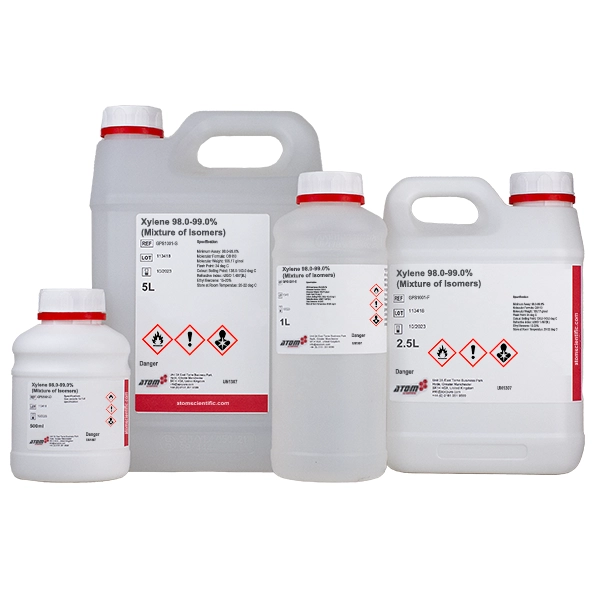Xylene 97.0-99.0% (Mixture of Isomers)

£5.95 to £71.95
| Variation ID | Pack Size | List Price | Qty | ||
|---|---|---|---|---|---|
| photo_camera | 500ml
GPS1001-D |
£5.95 | |||
| photo_camera | 1L
GPS1001-E |
£7.95 | |||
| photo_camera | 2.5L
GPS1001-F |
£12.95 | |||
| photo_camera | 5L
GPS1001-G |
£19.95 | |||
| photo_camera | 25L
GPS1001-K |
£71.95 |
Not to be used for ineligible purposes. This oil has not borne excise duty and may not be used as heating fuel, motor fuel or additive or extender to motor fuel.
What is Xylene? It is any of three organic compounds with the formula (CH3)2C6H4. They are derived from the substitution of two hydrogen atoms with methyl groups in a benzene ring; which hydrogens are substituted determines which of three structural isomers results. It is a colourless, flammable, slightly greasy liquid. The mixture is referred to as both xylene and, more precisely, xylenes.
Consistent Quality: We provide only high-quality Xylene 97.0-99.0% - Mixture of Isomers ensuring reliable and consistent performance for all applications.
Shipped from Manchester, UK Facility: Sourced and bottled in non-toxic, chemical-resistant containers to ensure safe handling and preserve product quality during transport.
Frequent Uses
Plastic production
Xylene (specifically p-Xylene) is the principal precursor to terephthalic acid and dimethyl terephthalate, both monomers used in the production of polyethylene terephthalate (PET) plastic bottles and polyester clothing. 98% of p-xylene production, and half of all xylene produced is consumed in this manner. o-Xylene is an important precursor to phthalic anhydride.
Industrial solvent
Employed as a solvent in printing, rubber, and leather industries. It is a common component of ink, rubber, and adhesives. In thinning paints and varnishes, it can be substituted for toluene where slower drying is desired, and thus is used by conservators of art objects in solubility testing.
Chemical temperature control
Used in the laboratory to make baths with dry ice to cool reaction vessels.
Light microscopy
Utilised as a solvent to remove synthetic immersion oil from the microscope objective in light microscopy.
Histology
It is the most widely used clearing agent. Used to remove paraffin from dried microscope slides prior to staining. After staining, microscope slides are put in xylene prior to mounting with a coverslip.
- PET plastic production
- Polyester clothing
- Solvent for printing, rubber, and leather
- Component of ink, rubber, and adhesives, paints, and varnishes
- Cleaning
- Dentistry
- Solvent in petroleum industry
- Light microscopy
- Histology
- Chemical reaction temperature control
- Plasticisers
M.F: C8H10
M.W: 106.17
Dry point: ≤ 143˚C
Initial boiling point: ≥ 137˚C
Benzene: < 0.01%wt
Density at 15˚C: 0.865—0.875g/ml
Appearance: Clear and bright
Cas Number: 1330-20-7
Einecs Number: 905-215-1
HS Code / Commodity Code: 3822900000
UN Number: 1307










